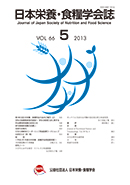All issues

Volume 66 (2013)
- Issue 6 Pages 279-
- Issue 5 Pages 241-
- Issue 4 Pages 177-
- Issue 3 Pages 127-
- Issue 2 Pages 69-
- Issue 1 Pages 3-
Predecessor
Volume 66, Issue 5
Displaying 1-3 of 3 articles from this issue
- |<
- <
- 1
- >
- >|
Review
-
(Young Investigator Award of JSFNS (2013) )Masao Yamasaki2013Volume 66Issue 5 Pages 241-247
Published: 2013
Released on J-STAGE: October 21, 2013
JOURNAL FREE ACCESSConjugated fatty acids are not a common form of lipid but have potent beneficial physiological functions. These fatty acids are promising candidates as materials for functional foods. We have established for the first time an analytical method for these fatty acids using gas-chromatography, which allows their disposition in tissues to be evaluated. Moreover, we have evaluated their physiological function and molecular mechanisms of action. As a result, we were able to demonstrate that conjugated fatty acid stimulated the production of immunoglobulin from the spleen and mesenteric lymph nodes in vivo and induced apoptotic cell death of hepatocellular carcinoma cells in vitro. Each conjugated linoleic acid (CLA) isomer exerts these functions individually or in association with others. In addition, monounsaturated fatty acid was found to alleviate CLA-induced apoptotic cell death. Here, we mainly introduce our studies on the physiological functions of CLA.View full abstractDownload PDF (468K)
Research Notes
-
Ayako Nagai, Masaru Kubota, Yukie Higashiyama2013Volume 66Issue 5 Pages 249-254
Published: 2013
Released on J-STAGE: October 21, 2013
JOURNAL FREE ACCESSTaste acuity is important for ensuring a healthy dietary intake. Fatigue or stress is thought to be one of several factors that may affect taste acuity. However, studies of the role of fatigue or stress in taste acuity, especially in children, have been rather limited. Therefore, we investigated the relationship between taste acuity and fatigue or stress in 58 healthy elementary school children. Acuity for differentiating four basic tastes (sweet, salty, sour and bitter) was evaluated using the filter-paper disc method. Salivary α-amylase was mea-sured as a marker of stress, and fatigue was assessed using the Chalder fatigue scale. When the subjects were divided into four groups on the basis of stress level, we found no difference in the prevalence of acuity disorders for the four tastes. Analysis using the Chalder fatigue scale demonstrated that the prevalence of taste disorders was higher in the fatigue group than in the non-fatigue group, i.e. physical fatigue; sour taste p=0.02, mental fatigue; salty taste p=0.03, total fatigue; sour taste p<0.01, bitter taste p=0.02. The present results indicate the possibility that fatigue in children may impair their acuity in recognizing certain tastes.View full abstractDownload PDF (468K) -
Makiko Kaneko, Masaki Miyake2013Volume 66Issue 5 Pages 255-259
Published: 2013
Released on J-STAGE: October 21, 2013
JOURNAL FREE ACCESSIn order to clarify the distribution and sensory characteristics of formic acid in cucumber fruit, we established analytical conditions for HPLC and examined methods for preparation of the fruit. The conditions for HPLC analysis that we developed made it possible to reproducibly analyze formic acid in cucumber fruit. The lower limit of detection in the samples used was 0.5 mg/L. The formic acid content of each part of the cucumber fruit was then analyzed by HPLC. The data obtained clearly showed that formic acid was present mainly in the peel and vascular bundles. The peel located near the peduncle contained an especially high concentration of formic acid. A standard low-concentration (<10 mg/L) solution of formic acid has an astringent taste, and both its taste and acidity become stronger with increasing concentration. The astringent taste of the peel due to the high concentration of formic acid (50-100 mg/L) . Furthermore, sensory evaluation suggested that formic acid was the main factor responsible for the astringency of cucumber fruit.View full abstractDownload PDF (5954K)
- |<
- <
- 1
- >
- >|